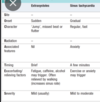Cardiovascular Flashcards
What can cause chest discomfort?
MI
Angina
Pericarditis
Aortic dissection
Oesophageal spasm
Pneumothorax
MSK pain
What causes breathlessness
HF
Valvular disease
Angiona
PE
Pulomary hypertension
Respiratory disease
Anaemia
Obiestu
Anxiety
What causes palpitiations?
Tachyarrhythmias
Ectopic beats
Anxiety
Hyperthyroidism
Drugs
What causes syncope/presyncpe
Arrhytmias
Postural hypotension
Aortic stenosis
Hypertrophic cardiomyopathy
Atrial muxoma
Simple faints
Epilepsy
Anxiety
What causes oedema?
HF
Constrictive pericarditiiss
Venous stasis
Lymphoedema
Nephrotic syndrome
Liver disease
Drugs
Immobiliyy
What does chest pain due to MI feel like?
Dull discomfort
Tight or pressing band like sensation
What is stable angina?
Episodes of pain percipitated by exertion and may occur more readily when walking in cold or windy weather
What is unstable angina?
Abrupt onset of worsening chest pain
Minimal exertion or at rest
What are these for angina


What are these for MI?


What are these for aortic dissection


What are these for pericardial pain


What are these for oesophageal pain?

What causes reduced ventricular contractility (systolic dysfunction)?
MI
Dilated cardiomyopathy
Myocarditisi
What causes impaired ventricular filling (diastolic dysfunction)
Left ventricular hypertrophy
Constrictive pericarditis
Hypertrophic or restrictive cardiomyopathy
What causes increased metabolic and cardiac demand (rare)
Thyrotoxicosis
Atriovenous distulae
Paget’s disease
What are causes valvular or congenital lesions?
Mitral and/or aortic valve disease
Tricuspid and/or pulmonary valve disease
Ventricular septal defect
Patent ductus arteriosus
Whagt should be asked about in acute dysponea?
Durationof onset
Background symptoms of exertion dysponea and usual exercise tolerance
Associated symptoms: chest pain, syncope, palpitation or respiratory symptom
What is the SOCRATES for extrasystoles?

What is the SOCRATES for sinus tachycardia?

What is the SOCRATES for supraventricular tachycardia?

What is the SOCRATES for atrial fibrillation?

What is the SOCRATES for ventricular tachycardia?

What are ectioic beats?
Benign cause of palpiation at rest and are abolished by exercise







